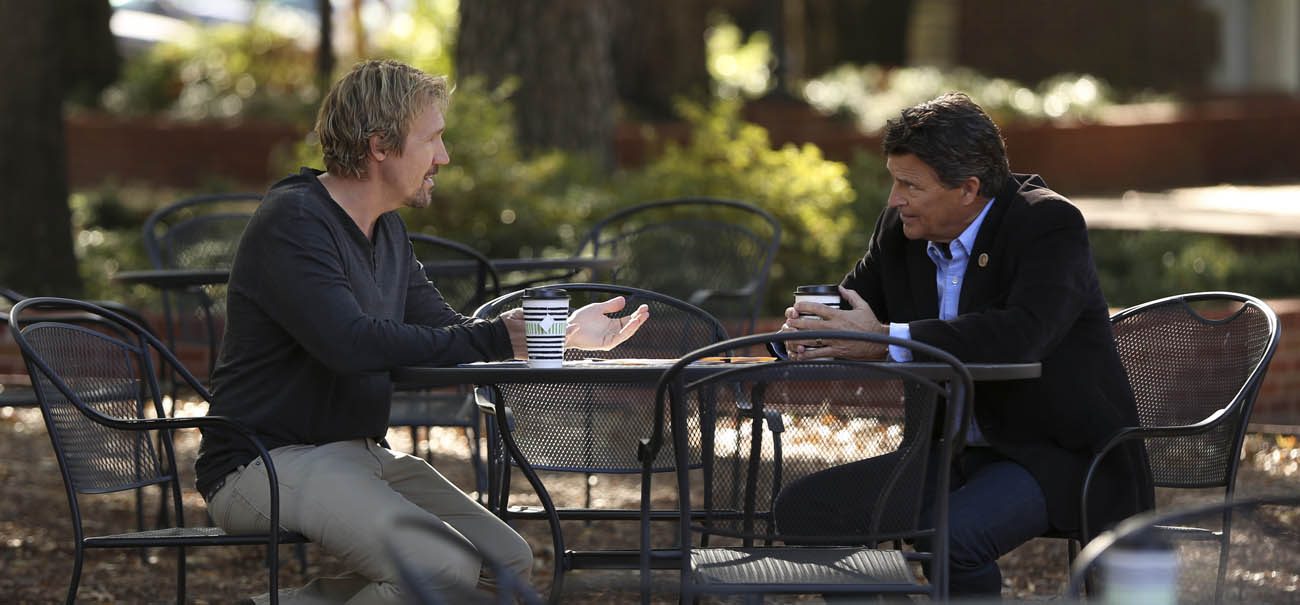NEW YORK (CNS) — Atheism is set at defiance once more in the franchise-extending drama “God’s Not Dead: A Light in Darkness” (Pure Flix).
Writer-director Michael Mason’s film, the second sequel to 2014’s “God’s Not Dead,” benefits from a less strident tone than its predecessors as well as a timely message about the dangers of intemperate political and cultural discourse.
Whether those assets will be enough to win this follow-up, which still has a somewhat alarmist tenor, the patronage of at least some viewers outside its built-in audience is another question.
[hotblock]
Reprising his role in the first two outings, David A.R. White plays earnest and amiable Rev. Dave Hill who, as the movie opens, is in the clink for defying a city ordinance that requires him to hand his sermons over to be scrutinized by the local authorities. (Something along these lines was attempted in real life by the city of Houston in 2014, via subpoenas.)
Though he’s quickly sprung, Hill’s troubles are just beginning. The state university on the campus of which his church, St. James, stands — it was built when the institution was a private one — wants the controversial pastor and his flock gone, and they’re willing to invoke eminent domain to accomplish this. Board member Thomas Ellsworth (Ted McGinley), who is also Hill’s friend, is given the unenviable task of breaking the news to him.
Hill decides to fight, and seeks out his estranged brother Pearce (John Corbett), a lawyer, to represent him in his court battle. But his difficulties multiply when Adam (Mike C. Manning), a student at the university whose latent resentment against religion has been riled up by the brouhaha, commits an act of vandalism against St. James that has entirely unintended but disastrous consequences.
Forgiveness and reconciliation are the foremost themes in writer-director Michael Mason’s film, which sees overwhelmed Hill getting into verbal and physical altercations with his adversaries, even as he tries to patch things up with former believer-turned-secularist Pearce. Adam, meanwhile, is tormented by remorse for the unexpected outcome of his initially petty wrongdoing but uncertain what to do to make amends.
[tower]
With bad guys more sympathetic than the outright villains who populated the previous movies, the script, instead of busying itself knocking down straw men, is able to strive for a broader embrace in its climactic appeal for harmony. And its warning that personalized attacks and the demonization of opponents — whatever sector of the ideological spectrum they may inhabit — can be counterproductive resonates in the current climate.
Catholic viewers will need to bring careful discernment to bear on a scene in which Adam, in revealing to his girlfriend, Keaton (Samantha Boscarino), the source of his antipathy toward the church, describes the reaction of his childhood parish to his mother’s decision to leave his abusive father. Ostracized, she was also told that if she remarried she would be committing adultery.
There are certainly more and less appropriate ways to convey and uphold God’s challenging teaching on this subject. So if Adam’s complaint is with the way Mom’s fellow parishioners turned it into a stick with which to beat her, fair enough. Given the context, moreover, it seems doubtful that the moment is intended as an apologia for divorce.
More charitable and calmer than its forerunners, “God’s Not Dead: A Light in Darkness” holds out the prospect that the series, having cleaned up at the box office, has begun to acquire the complacency of the prosperous. And, in this case, that may be no bad thing.
The film contains brief violence with slight gore. The Catholic News Service classification is A-II — adults and adolescents. The Motion Picture Association of America rating is PG — parental guidance suggested. Some material may not be suitable for children.
PREVIOUS: Movie review: Ready Player One
NEXT: Despite flaws, picture-filled Fatima books tell compelling story




Share this story